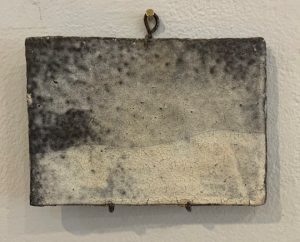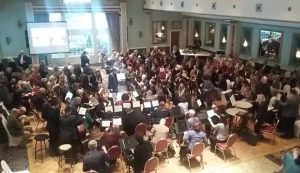The first few weeks of the COVID-19 pandemic lockdown were a time of sudden change for everyone. New routines had to be created on the fly, daily challenges overcome, and disruptions creatively solved. Teachers and students at every level turned to technology and ingenuity to continue their lessons. But what happens when your entire practice is hands-on, not just in terms of teaching but the materials and results? At West Chester University Ceramics Department, it resulted in the Wild Clay Harvesting Project.
Andrew Snyder, Associate Professor of Art at West Chester University, describes the situation that so many experienced:

March 2020: Guess I’m an online teacher now. I have a couple of questions, though.
Q: Can my students go to the studio to pick up materials?
A: No.
Q: Can I go to the studi—
A: No.
Q: How do I teach ceramics remotely? How will my students learn about clay in front of a screen from their kitchens, bedrooms, basements, closets, etc. without any clay?
A: Figure it out.
Switching mid-semester from in-person ceramics projects to teaching over Zoom was quite the challenge. Some adapted their lessons, using the time to focus on work that could be done with little more than their computer. “Rather than have my students write papers about ceramics, I wanted them to be creative problem solvers,” says Snyder. “I challenged them to prospect, harvest, and prepare their own clay using only the things around their home.”

“I was not concerned if they found clay. It was the process that mattered,” notes Snyder. “I assumed that most students would not find clay,” but his students, from their homes in cities and rural areas, nearby or several states away, all rose to the occasion: “to my delight, they ALL found clay.” It was a new prospect for teachers and students alike. “I had never harvested my own clay, so I was just as much the student,” says Snyder.
While Wild Clay has its origins in the initial lockdown, artists expanded upon their lessons for future projects. “I dug the clay in a runoff of the Brandywine river and hauled some 200 lbs. (wet) back about ¾ of a mile through the woods in sandbags,” says Austin Jefferson, one of the artists featured in the exhibition. This has become an inherent part of their work. “I typically use clay that I dig, but always adjust my process when adopting a new one.” Raw clay from natural sources always presents new challenges, even if it is from the same location. Jefferson explains, “I'll sketch out new forms and test decoration techniques that can benefit from the clay's working and aesthetic properties, establishing a fresh dialogue with the material.”

Taking clay directly from the banks of the Brandywine inspired a train of thought about the place of clay in the artistic tradition of the region. “If this area is artistically known for anything, it is the Brandywine School,” says Snyder. “I see and appreciate the clear mark of this tradition everywhere I go in Chester County.” Inspiration from the local landscape, whether in terms of subject matter or the medium itself, goes back much further. “When I consider historical art from this area as a ceramics artist, I think of the rich earthenware tradition that happened many years earlier than the ‘official’ Brandywine School,” explains Snyder. Hence the tongue-in-cheek “Not That Brandywine Tradition” tagline for the exhibition and the Wild Clay project at large.
“Over the course of the pandemic, I was fortunate enough to discuss wild clay harvesting approaches with Gerald Brown, Sam Diamond, and Austin Jefferson,” says Snyder. When it came to curating an exhibition, Snyder turned to these three artists to showcase their perspectives. “These artists used many of the same processes as historical potters from the original artistic tradition of the Brandywine River Valley, and this exhibition exemplifies their diverse approach to ceramics.”
“From my understanding, the Brandywine School wanted to establish a new American style and separate themselves from Eurocentric mode du jour,” says Jefferson. “I also want to develop a language, further distanced from the prevailing influences of folk and Japanese pottery here in the US.” The Brandywine Tradition serves as an inspiration to put a new spin on the traditions of the past. “I don't see myself in these old pots, so I make new ones. My intention is not to create facsimiles or appropriations but pieces that are reflective of my own American history.”

Jefferson notes, “I hope the exhibit will make people question tradition, both its roots, and relevance. At the very least, I hope people realize that clay is everywhere, has existed before our time, and will continue to course through cultures beyond our own.”
Snyder has a clear message for not just his students but for all Ceramics Artists. When students said, “Wow! I didn't know that I could just dig clay out of the ground and make things with it,” he responded, “Yes, it's everywhere! Go find some and make some pots.” The artists featured in Wild Clay responded, and the forms are as varied as the sites in which their materials were found, limited by nothing more than skill and imagination.
Wild Clay at The Art Trust, in conjunction with West Chester University Art + Design is on display through November 4th. The Art Trust is located at 16 West Market Street, West Chester, PA. More information can be found at TheArtTrust.org.
About Victoria Rose
Victoria Rose (she/her) is an editor, writer, avid reader, self-described geek, and fan of all things creative. Her passion for words has led to her current career as a freelance editor, and she is the owner of Flickering Words, an editing service. When not wielding a red pen (or cursor), she loves reading books of all genres, playing video, board, and word games, baking ridiculous creations to show off on the internet, or enjoying the gorgeous outdoors. She is a board member of the West Chester Film Festival and part of the Thirsty Monsters, a team of streamers from around the world who fundraise for various charities supporting LGBTQIA+ and accessibility rights. She can be found online @WordsFlickering or the Brandywine Art Guide @BrandywineArtGuide.
- Web |
- More Posts(115)





Comments